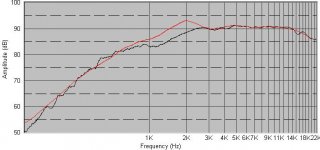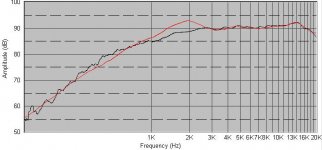Svante said:The reason for the roughness of the curves is that the microphones are spaced a bit apart (4 cm as I recall it).
Oh, duh! Should have thought of that..... Thanks for clearing that up. =)
Yes, I do believe that the 12mm capsule is the cause of the bump. In that other thread (which I need to find) there are links to some great info about that effect, precisely.
Zero Cool said:I just finished testing 7 RTA type mics for a future magazine article. the ECM-8000 included
Wow, that's not zero cool, that maximum cool. Let us know when and were to find the article.
I remember the THX cinema calibration systems of the early 90's It was a little laptop (rare at the time) that had several mics attached - it was at least 4 mics, maybe more. You could take readings at all the THX specified places in the cinema at once. Very cool. Little Countryman mic capsules, IIRC.
This may seem like more of a Speaker Workshop question than anything else, but it's my thread so . . . 
Are mic cal files usually the response plot (like we're seeing above), or an inverse that gets added to the signal to balance it out?
I'm going to try some re-measurements tonight and want to make sure I'm using the cal files the right way.
Great discussion, though. This has cleared up a lot. Sadly, I can't afford to spend $500 on an EarthWorks
Are mic cal files usually the response plot (like we're seeing above), or an inverse that gets added to the signal to balance it out?
I'm going to try some re-measurements tonight and want to make sure I'm using the cal files the right way.
Great discussion, though. This has cleared up a lot. Sadly, I can't afford to spend $500 on an EarthWorks
arc2v said:Sadly, I can't afford to spend $500 on an EarthWorks
AHHHHHH But you DON'T NEED too! hence why we did the mic testing and why we are writing the article.
The Earthworks mics are superb don't get me wrong. they are very good. BUT, for home speaker builders and Sound system guys there are a number of mics under $250 and one under $50 that have specs as good and in one case much better then a B&K 4010! and much flatter then the Earthworks we tested!
If someone was going to purchase a budget mic today. contact me off list and i might be able to influence your decision.
Zc
Yes, and it's centered around 0dbarc2v said:This may seem like more of a Speaker Workshop question than anything else, but it's my thread so . . .
Are mic cal files usually the response plot (like we're seeing above), or an inverse that gets added to the signal to balance it out?
I'm going to try some re-measurements tonight and want to make sure I'm using the cal files the right way.
Great discussion, though. This has cleared up a lot. Sadly, I can't afford to spend $500 on an EarthWorks
Are mic cal files usually the response plot (like we're seeing above), or an inverse that gets added to the signal to balance it out?
The calibration file gets subtracted from the actual measurement. Therefore a +ve value in the calibration file is for a mic that has a peak that needs to be subtracted, a -ve is for a dip (ie. at the low end) that should be added (minus a -ve = +ve added to the measured response).
Can someone clarify how / whether phase in the mic calibration is used (specifically for SW)? Presume it has to be, therefore any amplitude tweaks on the calibration file against say a referrence tweeter measurement would require HBT to be redone on the mic calibration?
Thanks,
David.
In SE it is, in SW, I can't exactly remember.Dave Bullet said:
The calibration file gets subtracted from the actual measurement. Therefore a +ve value in the calibration file is for a mic that has a peak that needs to be subtracted, a -ve is for a dip (ie. at the low end) that should be added (minus a -ve = +ve added to the measured response).
Can someone clarify how / whether phase in the mic calibration is used (specifically for SW)? Presume it has to be, therefore any amplitude tweaks on the calibration file against say a referrence tweeter measurement would require HBT to be redone on the mic calibration?
Thanks,
David.
I'm interested in the phase of the mic as well. I know in RoomEQWizard it just uses the dB values. When I made a SW frd file from that cal file, the phase was just 0 for everything. It appears to have worked (when you look at the same measurement with and without the cal file).
However, I don't know if I trust the phase measurements then. But as someone pointed out here, it is the relative phase of the drivers that matters.
I use this mic in my business (installer) so I'm going to have it calibrated. $112 seems cheap to get peace of mind.
This conversation has been an eye opener, though. I will ask how much more expensive it would be to get two cal files: one for vertical and one for horizontal.
A
However, I don't know if I trust the phase measurements then. But as someone pointed out here, it is the relative phase of the drivers that matters.
I use this mic in my business (installer) so I'm going to have it calibrated. $112 seems cheap to get peace of mind.
This conversation has been an eye opener, though. I will ask how much more expensive it would be to get two cal files: one for vertical and one for horizontal.
A
I suppose phase is irrelevant. What the phase is of the mic itself is probably irrelevent at a given frequency since it will be constant regardless of which driver is being measured at that frequency.
I am going to attempt recalibration using the reference tweeter method (well, that's what I call it). Whereby you measure the same model of a known to be consistent tweeter with a person who has a calibrated mic and also measured that tweeter, building a test baffle to match.
David.
I am going to attempt recalibration using the reference tweeter method (well, that's what I call it). Whereby you measure the same model of a known to be consistent tweeter with a person who has a calibrated mic and also measured that tweeter, building a test baffle to match.
David.
Yes, the phase response of the microphone matters very little. On the one hand its phase response will be added to the measured loudspeaker phase response, and the relative phase between drivers is important. On the other hand, if both drivers are measured with the same microphone, the relative phase will not be affected at all.
The only problems with non-zero microphone phase occur if one wants to use different microphones for the drivers, or if one wants to look cerafully at the phase response of the driver in itself.
The only problems with non-zero microphone phase occur if one wants to use different microphones for the drivers, or if one wants to look cerafully at the phase response of the driver in itself.
knorke said:Off topic question for Svante:
How do you import measured response data in Basta! ?
Hehe... I have the privilege of having the "next" version on my computer.
Zero Cool said:
If someone was going to purchase a budget mic today. contact me off list and i might be able to influence your decision.
Zc
Zero Cool,
I am about to buy the ECM8000. You could influence my decision. I tried to email you but I don't have enough posts. Perhaps you could email me?
Thanks, Mike
knorke said:Ahh...
When can we expect it to be released?
Btw. I like Basta! very much javascript:smilie('')...
Thx
I have made it a habit of not promising any dates for releases since it seems as if I get to regret it every time...I can say that I am working on a software for measurement though, and that it will be released simultaneously with that one. We'll see when they are released.
The mic was approx 125mm from the tweeter. given the dome diameter I consider this far enough away to be considered a farfield measurement.
I believe I can ignore the response below 2KHz. All the behringer measurements I've seen are pretty flat below 2KHz. I put the dip in my measurements due to baffle step compared to Seas measurements (my baffle isn't as wide).
To create my calibration file, I simply took an uncalibrated measurement of the 27TBFCG, then divided out the Seas measurement in SW to arrive at a calibration file for my mic.
To try and validate, I measured a 27TDFC/G then applied my calibration file. Black is my 27TDFC/G measurement, red is the Seas 27TDFC published.
I believe I can ignore the response below 2KHz. All the behringer measurements I've seen are pretty flat below 2KHz. I put the dip in my measurements due to baffle step compared to Seas measurements (my baffle isn't as wide).
To create my calibration file, I simply took an uncalibrated measurement of the 27TBFCG, then divided out the Seas measurement in SW to arrive at a calibration file for my mic.
To try and validate, I measured a 27TDFC/G then applied my calibration file. Black is my 27TDFC/G measurement, red is the Seas 27TDFC published.
Attachments
- Status
- This old topic is closed. If you want to reopen this topic, contact a moderator using the "Report Post" button.
- Home
- Loudspeakers
- Multi-Way
- ECM8000 Orientation for Speaker Measurements

